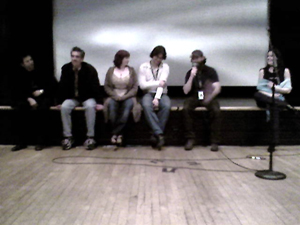Musings
an Online Journal of Sorts
By Alyce Wilson
April 10, 2006 - Indie Life
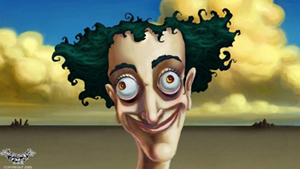
"Life in Transition" by John R. Dilworth
This was the second weekend of the Philadelphia Film Fest, and the Gryphon and I caught three showings on Saturday, all at the International House on the University of Pennsylvania campus. The films were great; the service, weird.
As we walked into the building for the first showing, The Shutka Book of Records, we were greeted by a film festival volunteer who was walking into the lobby, asking if anyone was there for the movie. I said that we were.
"Do you have your ticket?" I said yes. "Is it in your pocket?" he asked. Um, what?
The volunteer barreled ahead of us up the stairs into the lobby. Upon arriving at the doors of the movie theater, he announced to all who were waiting that, "We won't even open the doors until 2:30."
"The movie starts at 2:30," The Gryphon told him. He quickly corrected himself and said 2:15. Then he announced where the lines were supposed to line up for ticket holders and pass holders and busiesd himself corralling other festival volunteers.
I was half listening to him while perusing a book of poetry I'm reviewing for Wild Violet. All I can say about the guy is that everything he did was slightly off. As he was introducing himself to the other volunteers, as he was apparently their manager for the day, I heard him asking a guy who looked like he might be Jewish, "So, what's your Christian name?"
He was also wearing his festival T-shirt over a lime green turtleneck. I hadn't seen that look — on a guy, anyway — since about 1985. Like I said, slightly off.
The Gryphon argued that this term was in common usage among certain cultural groups. He, being a middle-aged African-American man, might be used to using that term. OK, no harm no foul, I guess.
But then came the last straw. When the time finally came to take our tickets, and the ticket taker began to tear the blue, prepaid tickets we'd purchased through TLA, the festival organizers, Green Turtleneck called out, "No, those aren't tickets. They're screening passes. You have to trade them in at the box office." He pointed down the stairs to the front door, where a festival volunteer was handling a mass of people buying tickets at the door.
Maybe it was the cold, rainy day that caught me unawares in a spring coat. Maybe it was because I'm premenstrual. Maybe it's because I'd had to listen to at least 20 minutes of Green Turtleneck's inanity, but I lost it. "No way! We've never had to do that before! This is a ticket."
"Calm down, calm down," a female volunteer said. She turned to Green Turtleneck. "It is a ticket," she said. He insisted again that it wasn't, and I was about to launch a reply when she assured him it was.
Then, our tickets torn, the situation handled, we were headed for the theater entrance when he said, "Calm down. No reason to get upset about it."
"I don't usually," I mumbled.
"Then
try not to today," he said, as if I was the one who'd been standing
in the lobby for the past 20 minutes spewing nonsense. I asked the closest
volunteer what his name was in order to tell someone at TLA about him,
but when she didn't know, I figured it was a sign to let it drop.
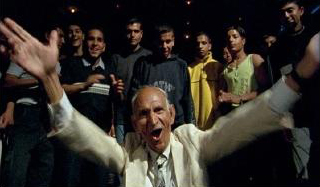 Despite
the unpleasantness, I very much enjoyed The Shutka Book of Records,
a Czech film directed by Aleksandar Manic about a small village on the
edge of the Balkans populated by the Romany people, or Gypsies. Rather
than approaching the film, which was a documentary, from a dry, outsider's
perspective, the film instead tells the story through the eyes of several
town characters.
Despite
the unpleasantness, I very much enjoyed The Shutka Book of Records,
a Czech film directed by Aleksandar Manic about a small village on the
edge of the Balkans populated by the Romany people, or Gypsies. Rather
than approaching the film, which was a documentary, from a dry, outsider's
perspective, the film instead tells the story through the eyes of several
town characters.
Each of them claims bragging rights to being the champion of some field of expertise, ranging from training fighter geese to collecting Turkish pop music. While some of the town's denizens may very well be exaggerating their accomplishments, it only adds to the playful portrait of a community, demonstrating how, even in extreme poverty, culture and interconnection makes their lives rich and fulfilling.
All of our films that day were at the International House theater, and I was worrying about the earlier confrontation. As it turned out, I needn't have worried. Green Turtleneck appeared to be on break between our first and second film. We didn't have much time in between, and it was about lunchtime. Fortunately, there was a little lunch counter in International House, which is also a student dorm. I ordered chicken noodle soup and an orange, along with a can of diet Red Bull. The Gryphon had Italian wedding soup and a coffee.
We ate at a little table and talked about the film. The Gryphon hadn't liked it as much as I had; he said he was expecting more of a traditional documentary.
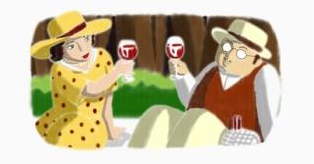 We
didn't have any problems getting seated for the next showing, a collection
of animated shorts called My Life in 'Toons. This was a collection
of shorts put together by the film festival, with the loose theme being
different ways of looking at life. Several of them were done by students
in the CalArts School of Film and Video, one of the premiere schools for
animation.
We
didn't have any problems getting seated for the next showing, a collection
of animated shorts called My Life in 'Toons. This was a collection
of shorts put together by the film festival, with the loose theme being
different ways of looking at life. Several of them were done by students
in the CalArts School of Film and Video, one of the premiere schools for
animation.
First was a short called "The Fruit Tree of Galilee" by CalArts student Eric Favela. (You can view a different short by him here.) This was traditional hand-drawn animation of a guy sleeping under a fruit tree. He gets hit on the head with an apple, which he eats and then turns into a frolicking monster. The short was witty and playful, and the audience loved it.
Then was another CalArts short, a simple computer animated piece called "Noobies" by Benjamin Vu. The characters and background are very simple geometric shapes, and it tells the story of a man who climbs a mountain to read quietly, only to be followed by two annoying young people who can't stop praising the view. This also a lot of laughs, especially when the youngsters fall victim to a neophyte mountain climbing fate.
Next was "My Little Obsessive Compulsive Friend" by Steven Adam Macleod, also a CalArts student. This was also hand-drawn, and it was just at the line drawing stage. The character style was very reminiscent of classic Disney. The story was simple: a boy playing with his pet mouse, whose obsessive compulsion behavior leads him to make neat rows of grains of rice. This was simple and well done, which added to its charm. Another funny delight.
Another CalArts project followed, "Asleep at the Wheel" by Sean Jimenez, whose short was a finalist in the 2005 Adobe Design Achievement Awards. (More info on the short can be found at Adobe.com.) Everything was drawn by hand and then scanned into Adobe Illustrator and completed using Adobe After Effects and Adobe Premiere. This is a dream-like piece with minimal movement, as a sleeping man drifts out of his bed and through tableaux in his town. The artwork is distinctive, with elongated figures and faces reminiscent of satirical cartoons.
This was followed by the CalArts short "Cat Food" by Nate Wragg. This was a hand-drawn short about trick-or-treaters, with two boys trying to frighten a little girl about the bloody fate that awaits her if she knocks on an elderly lady's door. The animation is a blend between more realistic and very expressionistic drawing styles, some of which are reminiscent of 1970s psychedelic artwork, perhaps influenced by Hunter S. Thompson's long time illustrator Ralph Steadman. Unfortunately, the sound was poor, and that's a problem because it's important to understanding this one. Still, the idea was interesting, and it was fairly well executed, if clearly not a professional piece.
Then was "Latent Sorrow" by CalArts student Shon Kim. This film, which the filmmaker calls a moving painting, has been exhibited at lots of film festivals, including the Experimental Film and Video Festival 2005, where it won the Fuji Film Eterna Award. This started out with very abstract shapes, much like ink blots moving to music, and eventually progressed into glimpses of human faces amongst the abstract. The effect was like staring at an abstract painting until you think you see recognizable shapes.
Next was "Gustavo: A Day in the Life of a Very Hairy Man" by Australian animator Jonathan Nix, who did the sweetly romantic short "Hello" which played at last year's festival. "Gustavo" is very minimalistic. A hairy man, Gustavo, stands on a white plain, intermittently scratching himself, as hair grows out of every exposed piece of skin. It took me a long time to figure out what was happening, and the eventual punchline is a long time coming.
This was followed by the colorful "At the Quinte Hotel" by Bruce Alcock, a Canadian commercial director who has worked in live action, CGI, drawings, photo-animation, film scratching and clay. This short illustrates an original poem about an evening in a bar, read by the poet, Al Purdy, in a marvelously expressive gravelly voice. This was really fun: a blend of hand drawn animation and claymation. I loved this one. The poem itself reminded me of Charles Bukowski, and the animation fit the poem extremely well.
Much to its credit, Swedish animator Malin Erixson's "Death by Heart" was seven minutes long but so well-constructed that it seems much shorter. This is a simple tale by a narrator about a friend of his, a hypochondriac named Conrad, whose friends have nicknamed him Hypoconrad. The film is hand drawn, with simple black and white characters on a background done with a red and gold wash. The narrator, a nebbish who can't get up the nerve to tell his friend something important. The short is well-crafted, funny and even surprisingly moving.
Next was a hand-drawn masterpiece, "Life in Transition" by John R. Dilworth, president and founder of Stretch Films, a design and production studio for animation based in New York City. This features a strange-looking, almost clownish green-haired man on a very Dali-esque brightly lit, barren background. The character dances to music and transforms into various Dali-esque shapes, eventually becoming something entirely different. The art is gorgeous, with vivid colors, and the film reminds me of a Salvador Dali painting brought to life.
Then was "cNote" by two-time Oscar nominee Chris Hinton, a Canadian animator who teaches at the film program at Concordia University. This is a real departure from his usual narrative films, an experimental piece blending abstract forms with experimental music. Sometimes discordant, sometimes slow and halting and other times a burst of sound, he masterfully matches sound with movement. Still, the piece felt long and a bit indulgent.
Injecting a lighter note was "Dog Worries" by Chris Armstrong, director of animation 3D at the Academy of Art University in San Francisco. He has worked with Industrial Light and Magic on movies like "The Day After Tomorrow", "Men in Black II", "Star Wars: Episode I", and was animation supervisor on "Galaxy Quest". The film was his first independent short, and it tells the story of a man's conflict with a neighbor's dog. The drawings are very childlike, and it was computer animated, which allows for creative movement between scenes: in and out of windows, over fences, et cetera. The only drawback was a small one: it was probably meant for a smaller screen and became a bit pixellated when blown up to a full screen. The writing is brilliant: funny and clearly based on real life experiences. Everyone who has ever lived next to a badly behaved dog — or even owned one — could enjoy this film.
This was followed by one of the best traditional animators in the field today, Bill Plympton. This was "Guide Dog" and could be considered a sequel to his Oscar-nominated short, "Guard Dog". In it, a dog bounces into an agency to take a job as a guide dog, but his efforts to safely lead his clients produce humorously dire results. Like many of his shorts, the story is conveyed with no dialogue, but with an extremely expressive dog and through creative use of special effects. No one can top Plympton's trademark style of absurdist humor.
"Remote Paradise" was next, a short by Quebecois animator Frederick Tremblay. This hand-drawn tale tells the story of two children who go on an adventure after their TV goes on the fritz. The artwork is simplistic and childlike, and the storytelling is charming, much like a children's book in motion. There's also a serious message about the way today's youth are chained to pop culture instead of using their imaginations.
A longer piece, "Morir De Amor" by Gil Alkabetz, was next. The official site summarizes it so: "While their owner is having his siesta, two old caged parrots rake up memories from the past. This leads to unexpected consequences for the three of them." The hand-drawn short contrasts a black and white apartment with the brilliant watercolor of memory, with nostalgic character designs looking like 1940s illustrations, particularly the Curious George books by H.A. Rey. The short feels longer than it has to be, with long moments of the birds being bored in the apartment before the memories commence. The parrots also spend a lot of time singing along to the title song, which adds to the total length.
Next was "The Old Crocodile" by Koji Yamamura. A hand-drawn short, it consists of solid black characters on a simple tan background, looking much like an ancient ink drawing. The story, which has lots of dry humor in it, follows an old crocodile who is exiled by his family and swims away, where he meets and befriends a very trusting octopus. While it feels very much like a fable or like a Rudyard Kipling "Just So" story, the ending doesn't quite follow the pattern. While there is a sort of wry twist, there's no moral to the story.
This was followed by "The Possum" by CalArts student Chris Choy. The film is hand drawn, possibly animated on the computer, and it follows a persistent possum's efforts to steal an apple from a greedy orchard owner. The artwork looks like watercolor and marker, and there is plenty of humor in the short, which could be improved by condensing a musical interlude that interrupts the action.
Last in the program was "To a Man with a Big Nose" by Cecilia Aranovich. This hand-drawn short is an adaptation of a poem by Spanish author Quevado, which celebrates the miraculous qualities of a man's overly large nose. This whimsical piece was received well by the audience.
After this film, we had time for a break. We took a cab downtown and ate at the Italian restaurant, Di Pietro's, where I had a whole wheat pasta dish with fresh vegetables and a glass of beer.
Then it
was back to the International House for the last show of the evening,
Head Space.
As we stood in line, reading books, Green Turtleneck talked loudly to the people ahead of us about his daily life. He said that he doesn't work so he gets to do whatever he wants. But sometimes he misses his daughter, who's 13,000 miles away. To cope with these feelings, he goes to the gym, gets a massage, and then goes to dinner where he orders a filet mignon and a big glass of sour mash. Much more than I needed to know.
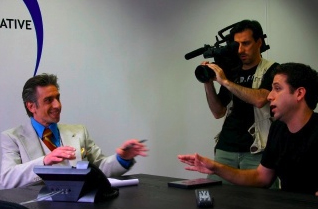 For
Head Space we sat in the front row. As we waited for the film to
begin, a guy sitting next to me asked me why we were there: "Are
you connected to the film in some way? And if not, what drew you?"
For
Head Space we sat in the front row. As we waited for the film to
begin, a guy sitting next to me asked me why we were there: "Are
you connected to the film in some way? And if not, what drew you?"
I told him we were attracted by the description in the program book and then asked him why he wanted to know.
He said it was because he was involved in the production of another film starring one of the actors from Head Space, and he liked to find out why people went to see movies.
Head Space was an independent mockumentary by local director Marc Erlbaum and produced by 9.14 Pictures. The movie features John Lumia as Hampton Shnellenger, the smarmy president of Get A-HeAD Inc., a company that sells tattoo advertising on people's foreheads.
The film was low budget, by Hollywood standards. During the Q&A afterwards, Erlbaum said their budget was $100,000, which was probably barely enough to pay the excellent cast, pay for locations, equipment rentals, costuming, props and any incidentals. The resulting film has a similar feel to NBC's The Office, with much of the humor coming from the juxtaposition between on-camera interviews and candid scenes.
Unfortunately, the showing suffered from some technical glitches, including a lot of sound drop-out near the beginning and some video stuttering. This was probably due to a formatting problem when the finished film was burned onto a DVD for the screening.
Lumia is the uncontested star of the movie, using body language and personal quirks to humanize an otherwise loathsome character. Little touches, such as Snellenger's love for puppetry, make him seem halfway between pitiful and dangerously deluded. And yet, he's craftier than he seems, acting as a sort of puppet master of those around him.
In the Q&A afterwards, I asked how much of the film was tightly scripted and how much leeway the actors had to improvise. Erlbaum said that it varied from scene to scene: some scenes were scripted and for others they simply knew the framework of what was supposed to happen. Lumia, for example, did a lot of improvising, including some of the funnier lines in the movie.
The filmmakers
said that they don't have any further showings planned of the movie, but
they're submitting it to festivals. Hopefully, they'll have some success.
If this film were available on DVD, I would definitely buy it and share
it with my friends. Head Space is to the marketing world what Spinal
Tap was to the music world.
More Musings from the 2006 Philadelphia Film Fest:
April 3, 2006 - Strange Desires
April 4, 2006 - Sweet Masterpieces
Musings on the 2005 Philadelphia Film Fest:
April 11, 2005 - Film Style 5+
Musings on the 2004 Philadelphia Film Fest:
April 12, 2004 - Indulging in Film
Moral:
There's nothing more fascinating than seeing life through another's
eyes.
Copyright
2005 by Alyce Wilson
What
do you think? Share your thoughts
at Alyce's message board (left button):
![]()
![]()
